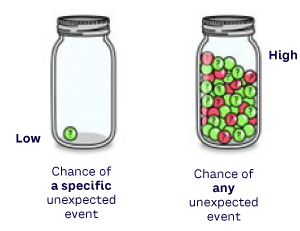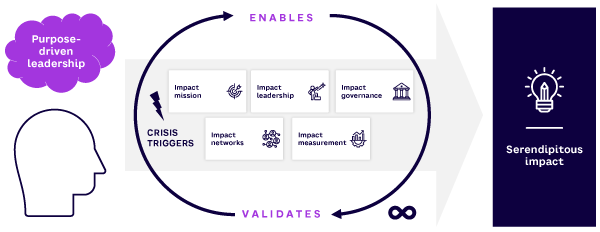AMPLIFY VOL. 37, NO. 9

Today’s workforce seeks meaningful employment, customers demand sustainable and transparent products, and investors expect companies to perform well financially while contributing positively to society.1,2 This requires alignment across the organization, based on a clear organizational purpose that is integrated across the organization. For instance, Patagonia’s mission to “save our home planet” aligns with its sustainable practices, influencing its entire supply chain. Similarly, Unilever’s “Sustainable Living Plan” initially aimed to decouple the company’s growth from its environmental footprint while increasing its positive social impact.
However, for organizational purpose to transcend superficial rhetoric and fulfill promises of engaged employees and loyal customers, companies must continuously and accurately assess the (intended and unintended) outcomes of their strategies. This ability is often missing. For example, while Starbucks supports initiatives such as ethical sourcing, it must measure the long-term social and environmental impacts of these initiatives, as well as its day-to-day operations, to truly validate its stated ideals.
In this article, we first discuss best practices around developing, assessing, and systematizing corporate impact then elaborate on the importance of developing purpose-driven structures and processes that allow the unexpected to be integrated toward what we call “Serendipitous Impact.”
Expected Impact
As organizations set specific, purpose-driven goals, there is a temptation to focus exclusively on new initiatives and their impacts (e.g., dodgy carbon offsets to achieve climate goals). However, it is particularly important to understand the entire organization’s impact and identify potential negative effects and unintended negative externalities of existing operations. Consider Uber, which aims to make transportation reliable for everyone. It has revolutionized ride-hailing, but it must also address socioeconomic challenges faced by its drivers, such as job insecurity and lack of benefits.
Organizations often measure their positive societal contributions by the amount they invest in “good works.” Shifting from merely measuring inputs (resources invested) to measuring outputs or outcomes is necessary but challenging. For instance, Microsoft’s “AI for Good” initiative tracks the number of projects it funds, but it should also assess tangible outcomes, such as the impact on environmental sustainability or healthcare improvements. Similarly, bold corporate statements about climate neutrality through offsetting often fall short of concrete effects on carbon emissions.
It is crucial to determine the extent of an organization’s contributions to these results, as well as possible positive or negative secondary effects. If Google’s sustainability efforts are supposed to reduce carbon footprints, for example, it is essential to measure both the direct impacts and the potential ripple effects on the broader tech industry and connected communities.
Disentangling the causal relationship between an organization’s activities and its effects can be difficult, particularly for long-term outcomes. One solution is for organizations to start measuring outputs that have a reasonable correlation with desired outcomes — they often are directly related to an organization’s efforts, and the data is often internally available (e.g., number of people fed). In contrast, outcomes like “improving food security” often require external information such as polling community members and tracking over time.
As organizations become serious about measuring the impact of their purpose, they need an infrastructure for collecting and tracking impact data. For example, SAP’s Green Token aims to provide an infrastructure connecting battery producers, automotive suppliers, and battery-recycling start-ups (a new approach to circular battery loops). It provides a material account that creates a digital representation of an electric vehicle battery (scrap or end-of-life) to black mass, which is then split into separate components such as lithium and cobalt, enabled by wet chemical processes.3
Orchestrating such processes for data on outputs and outcomes can potentially validate an organization’s efforts and inform management dashboards and decision support systems. Some organizations use sustainability data to improve energy efficiency across their supply chain, aligning daily operations with long-term sustainability goals.
However, impactful solutions often emerge unexpectedly, necessitating a dynamic approach to a company’s understanding of its impact.
Expecting the Unexpected
Navigating a world full of unexpected events requires maintaining a long-term vision while being open to the unexpected and adjusting accordingly. Ajay Banga, former CEO of Mastercard, spearheaded an effort to bring 500 million people who were previously unbanked into the financial system, but he clarified that if parts of the strategy did not work locally, the company would have to adjust it, opening it up to meaningful (social) innovations along the way.
That’s important because the unexpected is very likely, as Figure 1 illustrates. The chance of a specific unexpected event is low, but if you add up all possible unexpected events, it becomes highly likely that something unexpected will occur (e.g., an unexpected solution to a social or environmental challenge).
Therefore, successful leaders combine vision with adaptability, aligning short-term actions with long-term goals.4,5 This balance is crucial for navigating today’s complex business environment to leverage unexpected events.

Serendipitous Impact
Traditional strategies often fail to address the complexities of societal and environmental issues, which often do not have solutions a priori. Rather, they emerge along the way in collaboration with partners. Unexpected events and crises can trigger positive unintended outcomes; that is, Serendipitous Impact.
This impact occurs within the broader purpose field of the organization: although the exact impact is impossible to specify due to an ever-changing environment with limited information, direct integration of unexpected events into an organization’s core practices allows it to create impact without derailing its overall purpose.
The success of RLabs, an organization in Cape Town, South Africa, Cape Flats district, exemplifies this approach. Operating in a setting characterized by extreme uncertainty, RLabs turns crises into impactful innovation by creative use of limited resources. RLabs started out connecting residents needing emotional support via mobile phones. Over time, it evolved to offer training in social media and entrepreneurship, fostering hope by offering high-quality, low-cost education and creating related job opportunities.
This approach of leveraging what was at hand locally included integrating previously unemployable individuals to become teachers and using old garages as training centers —shifting its community’s focus from deficiencies to potential. This enabled people to make unexpected positive discoveries (serendipity, aka “smart luck”), as social and educational barriers were being removed, allowing people to continuously turn unexpected events into opportunities instead of being rigidly focused on a particular way of doing things. For example, when the pandemic meant that physical courses couldn’t be taught, RLabs began teaching short “nano courses.” The purpose (enabling hope by delivering high-quality, low-cost education) stayed the same, but the strategy and related impact emerged serendipitously.
Serendipity (making unexpected positive discoveries) involves the interaction of unexpected events and human action. Organizational members need to learn to identify unexpected opportunities, especially in crisis moments, and turn them into positive outcomes. That way, an unexpected event (e.g., the pandemic), based on a clear purpose (enabling local communities to get high-quality education access), can turn into a serendipitous outcome (nano courses).
Figure 2 shows five core practices that help organizations proceed from purpose-driven leadership to Serendipitous Impact: impact mission, impact leadership, impact governance, impact networks, and impact measurement.6

5 Practices
Purpose-driven leadership cultivates Serendipitous Impact by turning unforeseen events into strategic opportunities (see Figure 2):7
-
Impact mission. Successful organizations define a clear “why” that guides their actions, continuously refining related strategies to align with emerging needs and demands. Establishing an effective impact mission requires continuously engaging stakeholders to understand their needs and expectations, incorporating their feedback to adapt and evolve, and communicating related emerging strategies effectively to inspire and motivate employees. United Nations Sustainable Development Goals (SDGs) and other frameworks are available to help organizations understand relevant societal issues. In the case of RLabs, the overarching mission that emerged in close collaboration with its stakeholders is to “reconstruct communities through innovation, technology, and education.”
-
Impact leadership. Cultivating adaptable leaders across all levels and embedded in the respective community is essential for driving impact based on emerging needs. It starts with providing ongoing leadership development and training and encouraging a culture of continuous learning. RLabs focus is on “champions,” in which multiple generations of local leaders work together to allow the transfer of explicit and implicit knowledge. Organizations can use simulations to immerse their leaders in realistic, high-pressure scenarios that can teach them to handle crises effectively.8
-
Impact governance. Establishing robust governance structures improves transparency, accountability, and ethical decision-making. Here, an organization sets both long- and short-term goals and continuously assesses global and local contexts to align them. Transparency builds trust and helps companies focus on their mission while adapting to the unexpected. Successful leaders respond to the unexpected through a collaborative structure that empowers local experts while holding leadership at all levels accountable through transparent processes.9 Embedding in local communities and empowering local champions helped RLabs quickly pivot to nano courses during the pandemic.
-
Impact networks. Building and leveraging high-efficacy networks enhances resilience and collective impact. This can include partnerships with local organizations, such as nongovernmental organizations, local governments, and local businesses. Setting clear, measurable long-term goals with partners that are aligned with your short-term goals sets a roadmap for sustained progress and transparency. Adapting feedback from multiple stakeholders and networks to iterate and refine strategies further improves the organization’s ability to achieve its mission within its broader ecosystem, becoming more resilient toward unexpected crises. RLabs works with local universities and partners to continuously align and scale its impact goals (adjusted to its local context), using simple rules (heuristics) to scale its approach.
-
Impact measurement. Developing metrics and frameworks to assess and communicate impact is crucial, as discussed above. Using simple, practical guidelines for budgeting and resource allocation is essential for regularly assessing and reporting on social and environmental impact. The Science Based Targets initiative (SBTi), for instance, provides standards, tools, and guidance to set greenhouse gas–reduction targets in line with what is necessary to keep global warming below catastrophic levels and achieve net zero emissions by 2050. SBTi uses data and analytics to inform decision-making, drive improvements, and improve long-term decision-making and strategic foresight.10 RLabs uses simple yet effective measures to understand community well-being locally, establishing additional legitimacy in the process.
Conclusion
Purpose helps leaders connect the dots between grand challenges, unexpected demands, and strategic responses. When purpose-driven leaders expect the unexpected, they incent their stakeholders to embrace uncertainty and guide their organizations through adversity and disruption. By adopting the five practices outlined in our Serendipitous Impact Framework, purpose-driven leaders can reframe crises into opportunities to innovate and create impactful solutions that often cannot be fully defined in advance.
References
1 Busch, Christian, and Lisa Hehenberger. “How to Evaluate the Impact of Corporate Purpose.” MIT Sloan Management Review, 27 July 2022.
2 Tsang, Patrick. “How Sustainability-Driven Enterprises Can Build a Better Future.” World Economic Forum, 28 June 2023.
3 “SAP Green Token.” SAP, accessed September 2024.
4 Busch, Christian. The Serendipity Mindset: The Art and Science of Creating Good Luck. Riverhead Books, 2020.
5 Busch, Christian. “Towards a Theory of Serendipity: A Systematic Review and Conceptualization.” Journal of Management Studies, Vol. 61, No. 3, November 2022.
6 Busch, Christian. “Toward an Enlightened Form of Capitalism: The Changing Role of Private Organizations in the Context of Global Affairs.” In The Future of Global Affairs: Managing Discontinuity, Disruption and Destruction, edited by Christopher Ankersen and Waheguru Pal Singh Sidhu. Palgrave MacMillan, 2021.
7 Busch (see 6).
8 These can involve creating simulated environments where leaders can practice decision-making and problem-solving skills under stress, followed by validation of their impact through feedback and analysis by experienced experts. Grounded in historical events or plausible future scenarios, these simulations can incorporate multimedia elements such as audio recordings, video footage, and interactive decision points. During immersive training sessions, leaders engage with the simulations in real time, evoking genuine emotional responses and fostering deeper understanding. Small group discussions and immediate feedback refine decision-making processes. A post-simulation analysis by experienced experts allows for deeper reflection of experiences and actions, considering intended and unintended consequences of the impact created. For an example, see: Raval, Anjli. “Crisis Simulations Force Executives to Make Better Decisions Under Stress.” Financial Times, 21 July 2024.
9 Companies increasingly use certifications such as B Corp to emphasize transparency, accountability, and ethical decision-making. The B Impact Assessment tool helps companies align their goals with global and local contexts by evaluating their impact on workers, communities, the environment, and customers. B Corps must amend their legal documents to commit to B Corp principles, reinforcing accountability. When implemented effectively, this commitment goes beyond mere signaling to provide greater transparency and inclusion.
10 “Standards and Guidance.” Science Based Targets, accessed September 2024.




